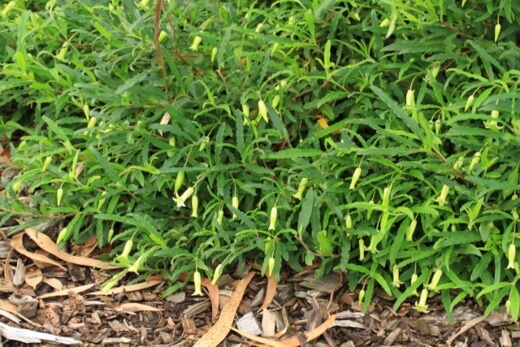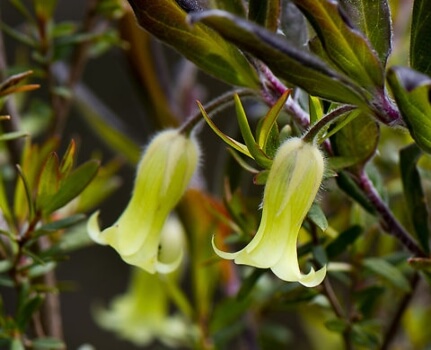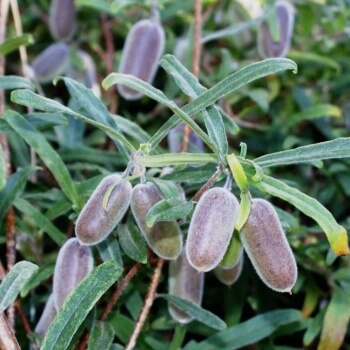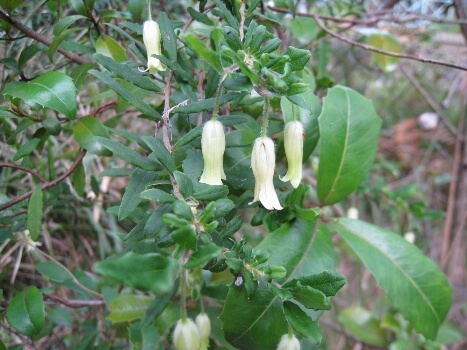Apple berry is native to the forests of south-eastern Australia. Lucky for us, it’s an easy to propagate and maintain shrub that bears beautiful and delicious fruit.
In our how to grow and care guide, we’ll introduce you to this native plant, talk through how to propagate from seed and cuttings, go through the care requirements for the shrub, and also how it fares as bush tucker. We’ll finish up with some pests and diseases that might affect your plant.
More...

Source: Woolshed Thurgoona Landcare
Family: | Pittosporaceae |
|---|---|
Genus: | Billardiera |
Species: | B. scandens |
Common Names: | Apple Berry, Apple Dumplings |
Location: | Outdoor |
Type: | Shrub |
Growth: | Up to 1.5 metres tall, Up to 3 metres wide |
Sun requirements: | Sun or shade |
Foliage Colour: | Green |
Flower Colour: | White, pink |
Flowering: | All year round |
Fruit: | Summer, purple to yellow |
Maintenance level: | Low |
Poisonous for pets: | No |
Introducing the Apple Berry Plant
Apple berry is native to Australia and is a great looking and incredibly versatile plant. It’s a climbing plant that can be used as a screen or groundcover, but also a shrub in a pot.
Billardiera scandens is incredibly tough and adapts well to any conditions. It doesn’t need much maintenance either. The leaves are a lovely glossy green colour and the flowers are a bell shape and either pink or white.
Birds absolutely love coming to help themselves to sweet nectar from the plant. Billardiera scandens is known more commonly as Apple Berry but also Apple Dumplings. This name is given because it’s a popular bush tucker plant in Australia.
The fruit that the plant produces are pretty in their purple and yellow colours, and these arrive in the summertime. The flavour of the fruit is similar to kiwi or a stewed apple. You can eat the fruit if it’s ripe, or otherwise roast it still unripe.
What’s great is that the apple berry plant can handle pollution, and is also safe for children and pets. Apple berry can handle a light frost and is evergreen, so it will look good in your garden throughout the year.

Source: Westgate Biodiversity
Propagating Apple Dumplings
How to Propagate Apple Berry from Seeds
When propagating from seed, the germination process varies hugely in terms of time. Sometimes it takes a few weeks, and in some cases can take up to a year. You can help the process along if you leave the seeds for a few weeks to ferment in water.
The best time to extract seed would be January, and your ideal time to sow the seed is at the beginning of spring or the summer time. You are able to keep any seed you have collected for up to 2 years if you are able to store it at room temperature.
When you are ready for sowing, do so on the surface and cover them just slightly. You don’t want to bury the seed. Keep your planting mixture moist but make sure not to over water. Just make sure the mixture doesn’t dry out at any point.
Temperature and growing conditions as well as how well the seed was prepped, will determine how long the germination process takes.
Propagating Apple Berry from Cuttings
The cuttings need to be semi-ripe, and you can aim for around 12 cm in length. You take the cutting by actually pulling away a section from the main stem. July or August is a good time to do this.


Get Your Free Guide:
Master Growing Australian Natives eBook
A Must Have Complete Guide for Every Australian Garden
Get Your Free Guide:
Master Growing Australian Natives eBook
A Must Have Complete Guide for Every Australian Garden
Try to pot your cutting as soon as possible but if you are going to store it, keep it in a plastic bag and store this somewhere cool and dry. When you’re ready to plant your cutting, dip the end into a rooting hormone and then plant it in the relevant container filled with compost and sand.
How to Care for Apple Berry

Source: JungleDragon
Sunlight Needs
When it comes to sunlight, the apple berry really isn’t picky. It can do anything from full sun to various degrees of shade, to heavy shade. That gives you plenty of options in terms of where to plant it in the garden.
Watering Apple Berry
Billardiera scandens is drought tolerant but giving it a moderate amount of water will keep it in optimum growing condition, especially during summer.
What Soil to Use
Apple Berry can grow successfully in a range of soils including sandy, clay, saline, and even the poorest of soils. The preference is dry and well-draining and the pH level can be acid, neutral, or alkaline.
Pruning Apple Dumplings
Regular pruning is recommended for the apple berry. This will help to promote growth and keep the desired shape and size that’s needed.
Fertiliser
Apple berry will do well with a blood and bone or slow-release native fertiliser.
Apple Berry Bush Tucker Guide

Source: Melbourne Bushfood
The fruit of the Billardiera scandens is considered a highly prized Australian bush tucker. The fruit only becomes ripe once it has fallen on the ground. Taste wise, they are similar to a kiwi fruit or the flavour of stewed apples. The overall flavour profile is light and spicy.
The fruit can be enjoyed as is when it’s ripe, or if not yet ripe, you can roast it as the Aboriginal people have done. You’ll want to remove the seeds before eating the fruit and with their purple colour, would look great in a fruit salad.
Looking for more foodie inspiration for your apple berry fruit? What about making jam or a tart?
Pests and Diseases that Affect Billardiera scandens
Armillaria Root Rot
This is a fungal disease that affects many categories of plants. Treatment includes getting rid of the tree bark and roots that have been affected. You’ll need to leave the roots exposed to try and stop the disease progression as exposure to air is what kills the fungus. Any pruned plant parts should be removed from the garden.
Powdery Mildew
Powdery mildew loves humidity and can easily spread in these conditions and with the right temperature. You can use an organic fungicide that contains sulphur or neem oil but potassium bicarbonate is also effective, and so is baking soda.
Rust
Rust disease is a group of funguses that mostly attack the leaves of a plant and the spores look like a rusty colour. You’ll need to get rid of all parts of the plant affected by the rust and then treat with an appropriate fungicide.
Phytophthora Root Rot
This type of root rot causes the more mature leaves of your plant to become a purple and red colour. Hydrogen peroxide is effective for treatment. You can apply a 3% solution of household hydrogen peroxide to the soil, using 1 part peroxide to 3 parts of water.
Apple Berry Frequently Asked Questions

Source: Wikipedia
In which parts of Australia would you not find the apple berry?
This plant is available in most parts of the country except for the Northern Territory and Western Australia.
What plant family does the apple berry belong to?
The small shrub is part of the Pittosporaceae family.
What is the natural habitat of the apple berry?
This plant can be found happily living next to a mountain stream or in forests. It also favours life by the coast.
Is apple berry considered a weed anywhere?
No it is not.
How big is the Billardiera genus?
It is considered a small genus of about 25 species.
Where does the name of the Billardiera scandens come from?
Billardiera is named after Jacques-Julien Houton de Labillardière who was a French botanist and scandens means climbing.
Looking for gardening advice? Sign up for our newsletter for more reviews and information.
Wrapping Up Our Apple Berry Plant Growing and Care Guide
A shrub that produces pretty and delicious fruit sounds like a plant I want to have in my garden. The prized apple berry is much loved by Australians for this very reason, and because it is hardy and low maintenance.
You’ll find apple berry a great companion in any area of your garden.
Published on December 22, 2022 by Lorri Hopkins
Last Updated on January 18, 2025




